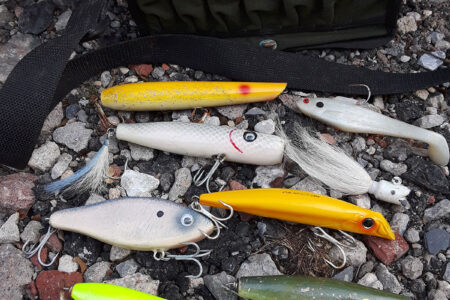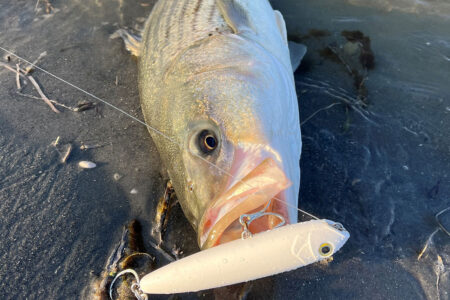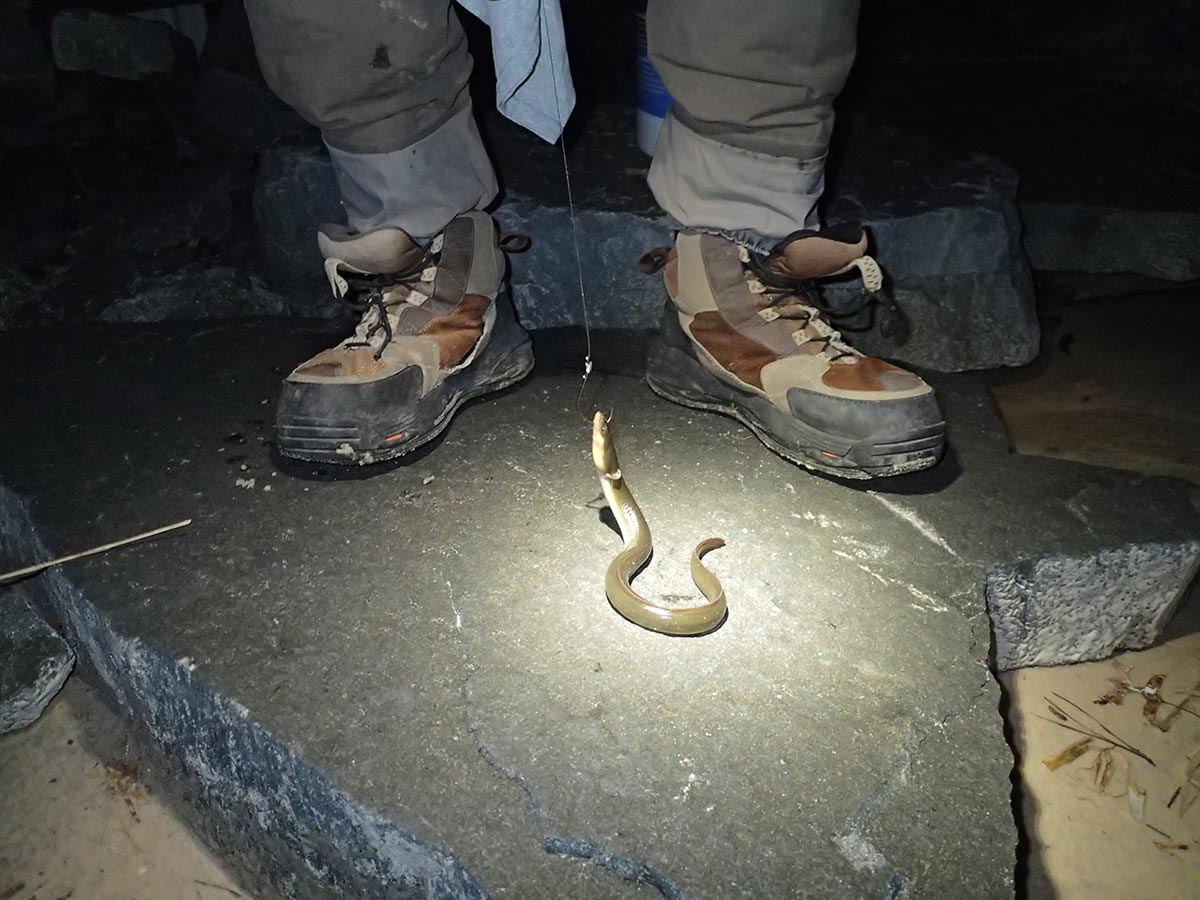
While most are home under the covers, the late shifters are having one wild night on the rocks!
Opposite of striped bass, American eels are panmictic and catadromous. That is they randomly mate within one large breeding population, and live most of their lives in freshwater while migrating to saltwater for spawning, respectfully.
The migration involves a fall exodus from rivers and bays to the Saragossa Sea, whereupon they spawn in winter, and subsequently return in spring. These antithetical migration patterns place eels in the crosshairs of stripers in both the spring and fall. It is not surprising then, that evolutionarily, striped bass have exploited this fortuitous crossroads and incorporated American eels as a staple in the diet.
Yes, technically speaking, eeling is a form of livelining. However, because of the dissimilar factors involved it should be considered a unique method all in itself. The optimal time, and location of application, varies from that of livelining conventional baitfish. For example, because American eels are nocturnal (combined with stripers being preferably-nocturnal), land-based eeling is exclusively performed at night.
Greater differences still, lie in the preparation and the storage of eels.
Burning Bridges
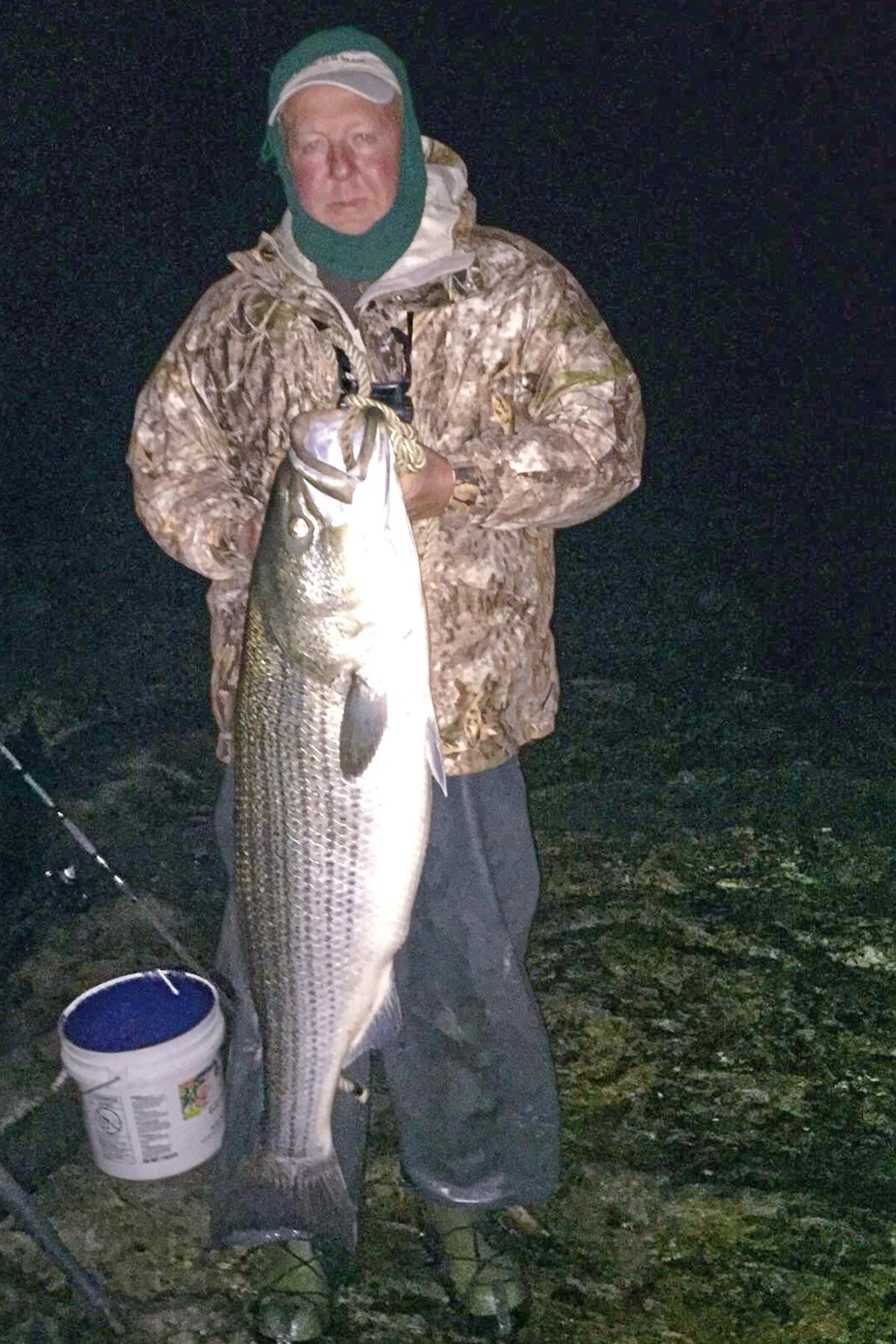
American eels tend to dwell around hard structure, predominantly rocky areas. An experienced angler’s first evocation of such would be jetties and boulder fields. These are indeed ideal for eeling. However, river bridge pilings, and bulkheads with neighboring tidal marshes also harbor eels. All such places allow eels feeding opportunities, where they can also ensconce themselves away from most pelagic predators. Unfortunately for them, striped bass are nicknamed rockfish for a reason.
Both eels and striped bass share a preference to areas around hard structure, another evolutionary fortuity of which the eel finds itself at the losing end. These are the spots where anglers can find success eeling for stripers, provided safety measures (like Korkers for gripping jetty rocks) are employed.
A fast action rod allows for monitoring the action of the eel and surveying bottom contour where you may be fishing. However, the action rating of the rod can range from medium to fast. If the specific location to be eeled requires wetsuiting – typical for the boulder fields of eastern Long Island and New England where you may be traveling to find stripers – a waterproof reel is also essential. The hook size varies depending on the size of the eels. The leader strength may also vary depending on the location being fished. Preferably, a 2-1/2- to 3-foot shot of 40- to 60-pound leader should be snelled to a 6/0 to 8/0 Gamakatsu circle hook.
The meticulous angler prefers a hook brand with a bent eye as it allows for proper snelling. This knot eliminates the potential hook-to-knot rotations that are always possible with improved clinch or polymer knots. It subsequently decreases (admittedly only by mere microseconds) the time by which the hook gets set. Another nuance lies in the reduced buoyancy of fluorocarbon leader to that of monofilament. In shallower areas, the less dense, more buoyant monofilament saves one from snags.
Slippery When Wet
Live eels can be tricky to use; they’re active of course, and their slimy bodies make them difficult to handle. Brillo pads, dry rags, and paper towels provide adequate grip. If however you’re in a situation where none of the above are available, just use a little beach sand. The sand will harmlessly stick to the eel’s slime coating allowing for grip. Additionally, the sand gives extra weight for the cast, and is shed when the eel contacts the water.
There are a number of ways to hook a live eel; some will blind them by running the hook through both eyes, others go in the mouth and out the bottom or top of the head. In my opinion, driving the hook through the bottom of the head and out the top is optimal. Because eels are so hardy, such trauma will not kill them within the time of their use. Unlike other hook placements, the skull and bottom jaw give added strength to keep the hook anchored in the bait. When implementing this method, much less often will an eel detach during a strong cast or bass strike.
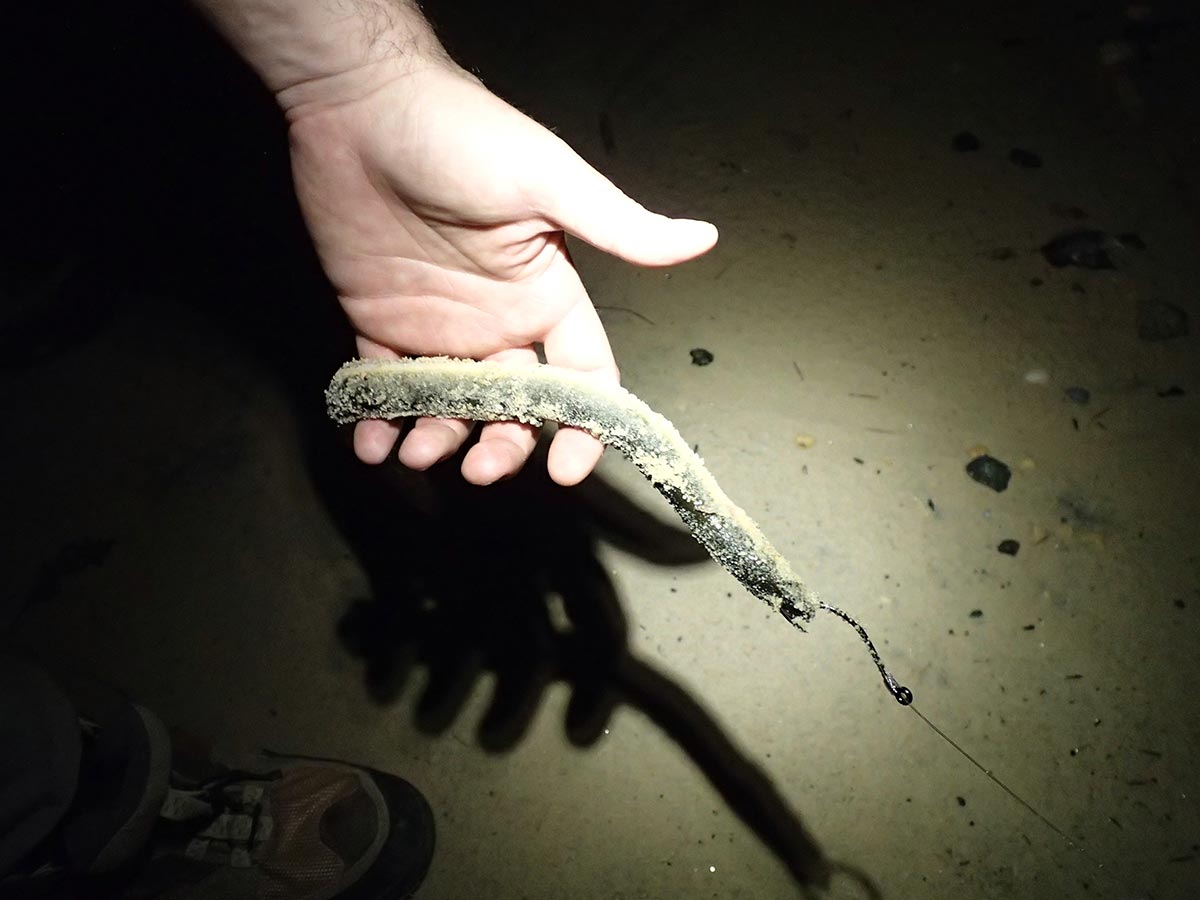
Unfortunately, American eels are often feisty and not willingly hooked as bait. So even after the hook is properly embedded, the eel can curl up on itself and knot the leader, rendering the offering useless. One way some fishermen circumvent this obstacle is to first break the eel’s back before use. Handicapped eels may be easier to manipulate but there are disadvantages to this exercise.
Firstly, the method for vertebrae-breakage either involves tools that rupture the skin, or the impact of a boot that can jet the slippery eel to its freedom, or at least away from the angler. Secondly, a paralyzed eel may be easier for a bass to subdue, but it’s more difficult for a bass to locate. Because some of the eel’s body is immobilized, there may be less emitting of distress signals into the water around it. This weaker signal will be slightly harder for a bass’s lateral line to detect.
Temporary, yet reversible paralysis can be achieved with ice however. When chilled, an eel’s body can go into a hypo-metabolic state where it moves very little. Although direct contact between the two should be avoided, ice in close proximity to eels will drop their core temperature to this end. The eels will remain mostly dormant until during the first retrieve, when the sea water has had time to warm them back into action.
Even between casts an angler may still be faced with newly revived eels balling their leader. Twitching of the casting-hand’s pointer finger to the line will often avert this mishap. This pulls the eel an inch up and drops it back down. The continuous momentum from the oscillation will halt the eel from curling. This should be done through the entire interval from when the eel leaves the water after the retrieve, till when it’s again recast.
Inside Out
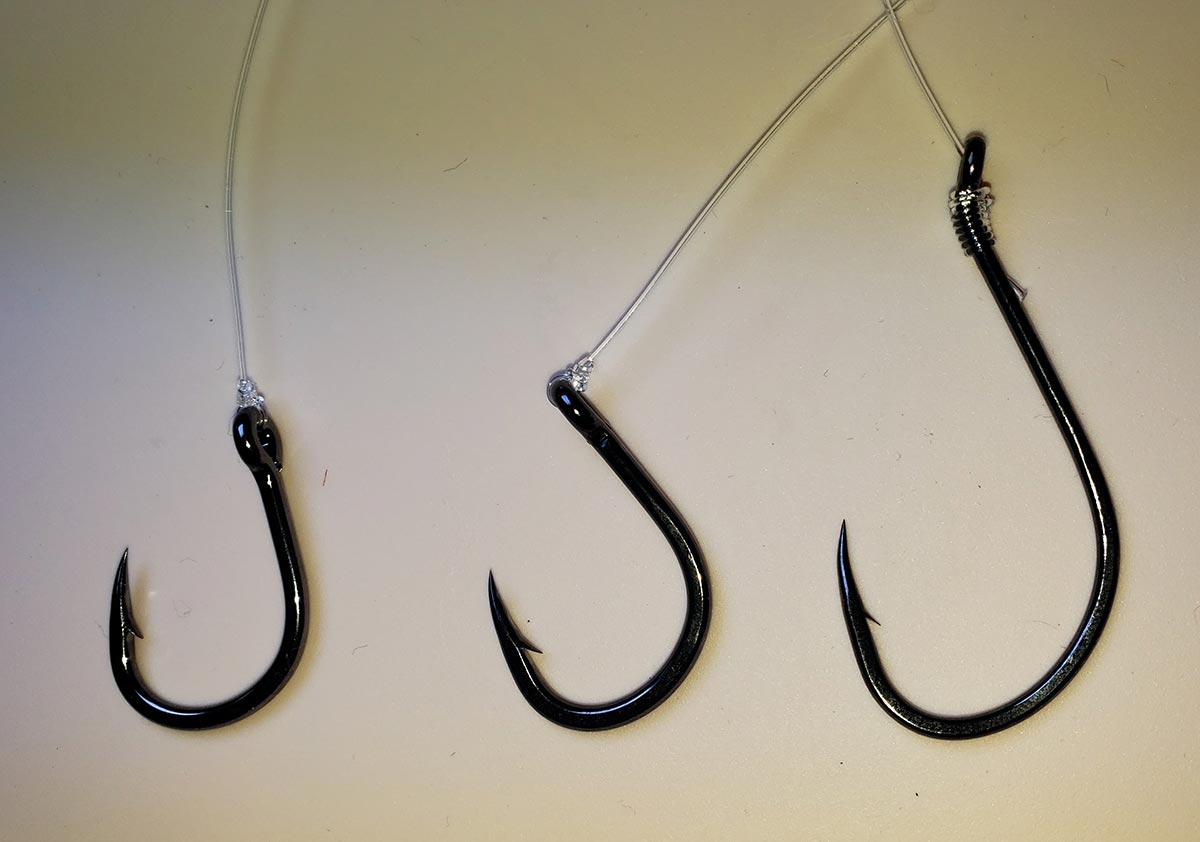
Eels should not be dead-sticked; doing so gives them ample time to ball up the leader. On the other hand, eels should not be retrieved fast either; even the speed of the slowest plugs can be too fast. The traumatized eel is alerting the neighborhood predators, causing no need for an unnatural retrieve. Let the eel do its job; just keep the line taut, with few feet reeled here and there so that the eel doesn’t ball the leader or snag bottom structure.
Eels are easier for a bass to inhale and ingest compared to adult menhaden. The time it takes for a fish to pull a vertical rod tip to point at the water is often enough for consumption. This is called “bowing to the fish” and has often been followed with a strong hookset. When using circle hooks, which will eventually be required coastwide when rigging natural baits for striped bass, this is the time for a steady retrieve until the rod is bowed and the fish begins its run. Because eels are engulfed much faster than many other live baits, the circle hook is extremely effective and most often successful in terms of the nonfatal jaw hooking of a striper.
When wetsuiting to the outer bar, or on road trips north along the Striper Coast to fish the boulder fields, it is not practical to have your eels iced down in a cooler or maintaining dry rags for their handling. The best approach is to have individual eels packed in separate small Ziploc bags; all grouped together in one larger pouch attached to your tool belt. The confusion of teasing the eels apart is not encountered as each is in its own Ziploc bag. It’s especially helpful in ventures involving the swimming to, and establishing of a precarious fishing position.
.
Once the eel’s head is located in the bag, the hook can be driven through the plastic bag and the eel simultaneously. The rupture in the bag can be torn further as the eel is pulled out. Just check to make sure there’s no residual plastic left on the hook. – AA
Unless one has access to safely caging their eels near a water-side dock, long-term storage requires a large, aerated tank of saltwater. Short-term storage of up to a week can be accomplished by other means; a waterless bucket, with only a wet rag that’s changed daily for example. The least efficient way, that’s surefire to kill the eels, is by keeping them in a small amount of unaerated water. They’ll quickly drown in their own emitted slime and waste. Any dead eels can of course always be salvaged into rigged eels and eel-skin plugs, but that’s a different article altogether.
When tons of bunker pods are in the area, you may find eeling has a far diminished probability of producing bass. But new and full moons move more water, and the higher current can improve an eeling bass bite. Keep in mind that when fishing shallower areas a bright full moon in a cloudless sky may shy bass away from feeding. There are always exceptions, but a good rule is that outgoing tide is the most productive, especially at inlet jetties. Various wind speeds and directions are more or less helpful, though are nuanced to specific location.


